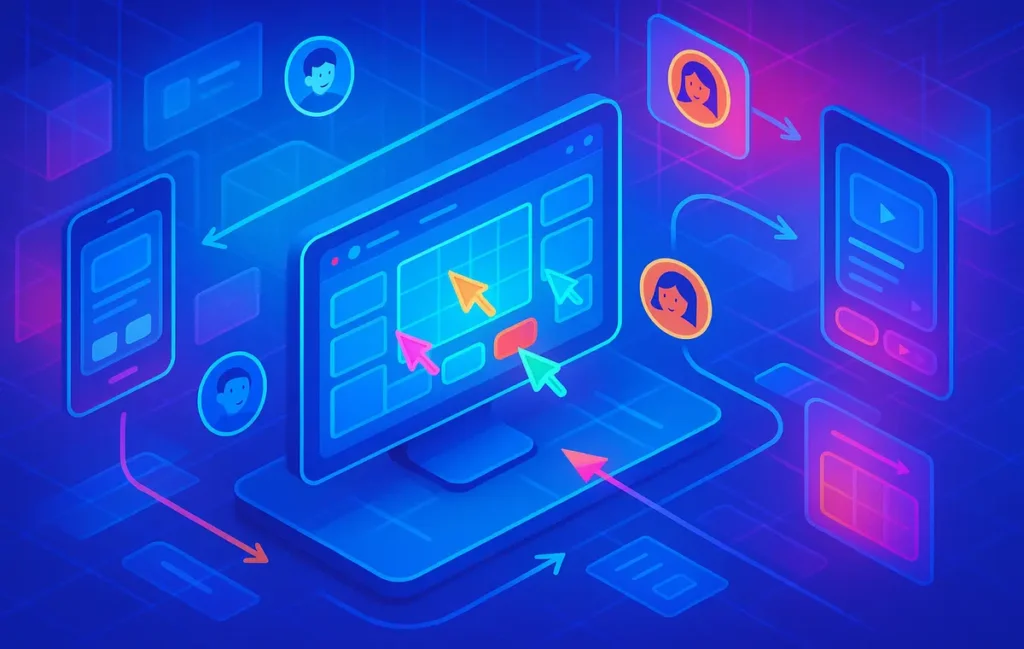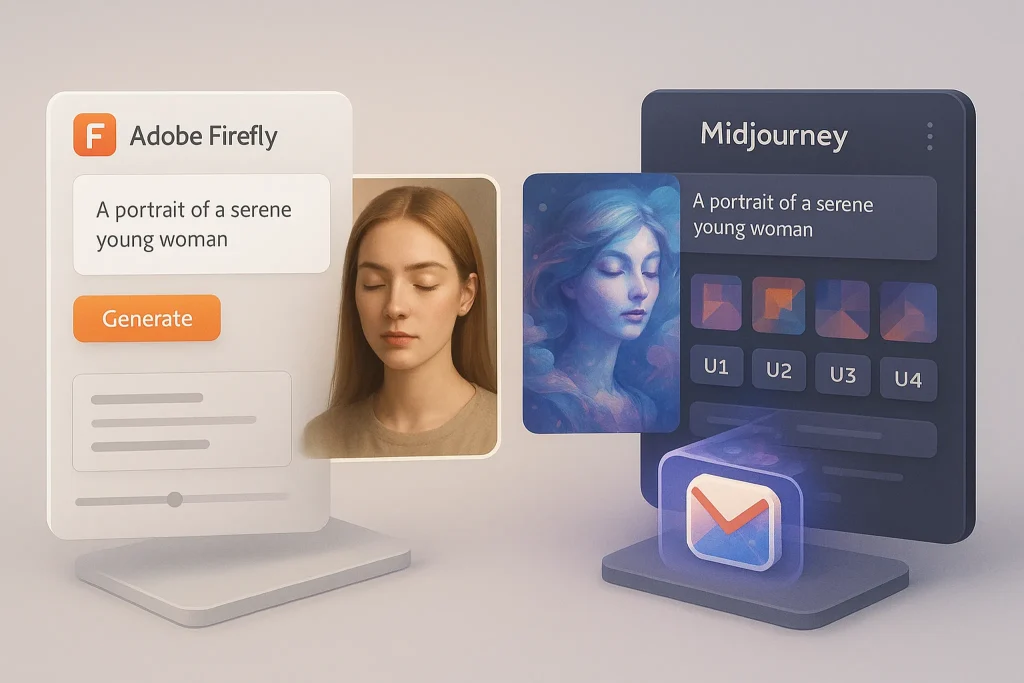🎯 Intro
Figma has transformed the design world. What used to require messy file transfers and endless email chains now happens in real time—like Google Docs for designers. Teams no longer wait for static drafts; they co-create, comment, and iterate together in one browser tab. In 2025, Figma has solidified its place not only as a design tool but as the centerpiece of modern product collaboration.
At NerdChips, we’ve seen the rise of no-code and AI tools for design, from Figma Make to new-generation no-code platforms. But among them, Figma remains the benchmark for collaborative, cloud-first design. Let’s dive into why.
🔍 What is Figma?
Figma is a cloud-native design platform for interface design, prototyping, and real-time collaboration. Unlike Sketch or Adobe XD, which started as single-user desktop apps, Figma was built browser-first from the start. That design decision changed everything—it meant design files weren’t tied to one machine. Instead, teams could work together, instantly, across platforms.
In 2025, Figma competes not only with legacy design apps but with emerging AI-native tools. Still, its advantage lies in how seamlessly it integrates into team workflows. Designers, developers, marketers, and PMs all connect in one space, making it more than just a design tool—it’s a collaboration hub.
Where Sketch requires plugins for cloud sync and Adobe XD integrates into Creative Cloud, Figma is ready out of the box. The difference is night and day.
⚡ Real-Time Collaboration Features
One of Figma’s most powerful features is multi-user live editing. Multiple team members can work on the same file at once, each represented by their cursor. This eliminates version control chaos. Instead of “Final-Final-V2.sketch,” teams always have a single source of truth.
Comments and annotations happen inside the file. Instead of sending screenshots over Slack, reviewers pin feedback directly on elements. Designers can resolve comments in real time, creating faster iterations and fewer misunderstandings.
Version history ensures that no mistake is permanent. Teams can roll back to previous iterations, compare changes, and branch off new design ideas without fear. For large teams, branching works like Git for design: teams explore bold directions without disrupting the main file.
💡 Nerd Tip: Use branching in Figma for large projects—it lets teams test design directions safely, just like developers manage code.
🛠️ Prototyping Speed
Prototyping in Figma is fast and intuitive. Instead of exporting assets into a separate prototyping tool, you build interactions directly in the design file.
Drag-and-drop connections create interactive flows instantly. Designers can simulate app navigation, transitions, and animations in minutes. Features like Smart Animate and Variants reduce repetitive work by automatically linking similar components.
This rapid prototyping loop is especially powerful for client presentations or internal approvals. Freelancers, for example, can deliver a working prototype in hours instead of days, boosting trust and winning contracts faster.
Combined with AI integrations, prototyping in Figma is even faster. Designers use AI to generate layouts, test color palettes, or refine typography, then adjust with human intuition. The feedback cycle has never been shorter.
📊 Why Teams Prefer Figma in 2025
By 2025, design has gone global and remote-first. Teams need tools that work seamlessly across devices and platforms. Figma answers this with:
-
Cloud-native architecture. No need for heavy installations. It runs in a browser, with desktop and mobile apps for flexibility.
-
Cross-platform compatibility. Mac, Windows, web, and even iOS/Android for quick access. Everyone is included.
-
Rich ecosystem. Thousands of templates, plugins, and widgets speed up design work. From accessibility checkers to icon libraries, the marketplace fuels productivity.
These reasons explain why Figma remains the go-to choice despite competition from AI-first design platforms. For teams building no-code websites or even experimenting with AI-powered creativity like Midjourney vs Leonardo AI, Figma provides the structured collaboration backbone that others can’t replace.
🚀 Use Cases
Figma fits into diverse workflows:
-
UI/UX design for apps. Startups and enterprises use it as their primary design system.
-
Remote teamwork. Distributed teams collaborate asynchronously, leaving comments, edits, and prototypes in one hub.
-
Freelancers and agencies. Fast prototypes impress clients, securing deals and shortening sales cycles.
One freelance designer we spotted on X put it bluntly: “Figma is my secret weapon. Clients don’t just see a mockup—they click through a live prototype the same day.” That immediacy is Figma’s biggest sales pitch.
⚠️ Challenges & Limits
Of course, no tool is perfect. Figma has challenges worth noting.
For massive files with thousands of elements, performance can lag, even on high-end machines. While updates in 2025 improved rendering speed, heavy projects still push limits.
Pricing is another concern. While Figma has a generous free plan, enterprise subscriptions can add up quickly for large organizations. Some teams debate whether cost justifies value at scale, especially when paired with other SaaS bills.
Finally, offline mode remains limited. While Figma offers some offline access, the real magic is cloud collaboration—which means poor connectivity can slow down workflows.
That said, most teams weigh these challenges against the gains in collaboration speed and decide Figma is worth it.
⚡ Design Faster, Collaborate Smarter
Figma’s free plan is perfect for individuals, while Pro unlocks advanced collaboration for teams. Try it to experience real-time design without friction.
🔎 Figma vs Competitors (Mini Comparison Insight)
To understand Figma’s dominance, it’s worth comparing it directly with its closest competitors—Sketch and Adobe XD. Sketch pioneered modern UI design but remained tied to macOS and relied heavily on third-party plugins for collaboration. Adobe XD came with Creative Cloud integration but lagged in real-time editing.
Figma, by contrast, offers native collaboration. Teams don’t need to buy additional software or set up complicated sync workflows. With plugins, template libraries, and cross-platform compatibility, it simplifies what its rivals complicate.
Here’s a simplified comparison snapshot:
| Feature | Figma | Sketch | Adobe XD |
|---|---|---|---|
| Real-time collaboration | ✅ Built-in | ❌ | ❌ Limited |
| Platforms | Web, Mac, Windows, Mobile | Mac only | Mac, Windows |
| Prototyping speed | High (Smart Animate, Variants) | Moderate | Moderate |
| Ecosystem | Extensive templates/plugins | Strong plugin community | Smaller ecosystem |
This table highlights why teams still choose Figma: speed, inclusivity, and collaboration-first design.
📊 AI in Figma (2025 Angle)
By 2025, Figma has embraced AI more deeply. Features like AI-powered layout suggestions, automatic asset resizing, and text-to-design generation help teams skip repetitive tasks. Instead of manually adjusting hundreds of components, AI detects intent and applies patterns across the project.
Figma AI also complements no-code workflows. Designers can mock up flows and export them into no-code builders like Webflow or integrate them with AI-first platforms similar to Google Opal. This AI-enhanced design workflow blurs the line between design and development, giving Figma resilience against emerging AI-native competitors.
💡 Nerd Tip: Use AI layout suggestions for wireframes, then refine manually for brand accuracy—best of both worlds.
🧩 Design System Management
Figma has become the backbone of modern design systems. Instead of scattered files and inconsistent style guides, teams create component libraries in Figma. These libraries enforce consistency across typography, colors, buttons, and UI elements.
For enterprises, this consistency scales. Global teams can pull from the same library, ensuring brand coherence across regions. For startups, it speeds up product iteration by eliminating repeated design decisions. As a result, Figma is not just a prototyping tool—it’s a brand consistency engine.
This feature makes Figma essential for teams building large ecosystems of products, from SaaS dashboards to e-commerce platforms.
🏭 Enterprise Workflow Stories
Consider a SaaS startup scaling fast. Before adopting Figma, its design team wasted time consolidating files from Sketch and passing them manually to developers. After moving to Figma, iteration cycles shortened by 30%, and feature delivery timelines improved significantly.
E-commerce brands also benefit. With Figma’s real-time prototyping, marketing and design teams collaborate on product landing pages in hours, not weeks. These case studies highlight why enterprises justify Figma’s subscription costs: it doesn’t just improve design—it accelerates business outcomes.
🔮 Figma + Developer Handoff
Figma bridges the once-painful gap between designers and developers. With code snippets (CSS, iOS, Android) and integrations into developer tools, Figma reduces handoff friction. Developers can inspect designs, copy styles, and export assets directly, removing the ambiguity that used to plague collaboration.
This “handoff harmony” is critical in large teams. Developers no longer complain about unclear specs, and designers spend less time documenting layouts. Combined with plugins, handoff becomes part of the natural workflow. It’s another reason enterprises view Figma as more than a design app—it’s an operational necessity.
📈 Limitations vs Opportunities
While Figma dominates, it faces new challenges. AI-native tools and no-code builders (like Framer and emerging AI design startups) threaten to replace parts of its workflow. These tools promise instant design generation without human input, something Figma still treats as supplementary.
The opportunity lies in integration. By embedding AI deeply into collaboration, handoff, and design systems, Figma can remain the backbone while AI accelerates tasks. Its cloud-first ecosystem gives it an advantage: new tools plug into Figma, not the other way around.
For teams choosing between AI-native platforms and Figma, the deciding factor is scale: Figma is built for collaboration at all levels, while AI-native tools are still catching up.
🛡 User Voice & Quotes
The best reviews often come from users themselves. Here are real-world perspectives from designers in 2025:
“Figma saved us hours every week. It’s basically our team’s whiteboard + Photoshop + Slack in one.” — UX Lead, SaaS startup
“As a freelancer, I close deals faster because clients can interact with prototypes instantly. No static PDFs, just clickable flows.” — Independent designer on X
“Our e-commerce team cut landing page design cycles by half after moving to Figma. Collaboration is night and day compared to old tools.” — Marketing manager
These voices highlight the lived reality: Figma is not just about features—it’s about workflow transformation.
📬 Want More Smart Design & AI Insights?
Join our free newsletter for weekly tips on design tools, no-code platforms, and AI-powered workflows—curated by NerdChips for modern creators.
🔐 100% privacy. Just future-focused insights, no noise.
🧠 Nerd Verdict
In 2025, Figma remains the leader in collaborative design. Its speed, cross-platform flexibility, and community ecosystem make it indispensable for startups, agencies, and global teams alike.
Its only drawbacks—performance on heavy files and enterprise pricing—are small compared to the productivity gains. If design collaboration is your bottleneck, Figma eliminates it. NerdChips sees it as not just a design tool but a strategic enabler of modern product building.
❓ FAQ: Nerds Ask, We Answer
💬 Would You Bite?
If you could design with your entire team—like editing in Google Docs—would you still stick to old-school tools?
Crafted by NerdChips for creators and teams who want their design workflows to move at the speed of collaboration.



